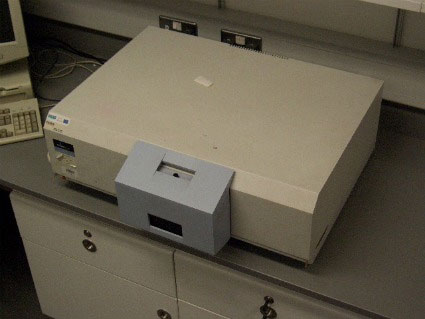Perkin Elmer LS55B Luminescence Spectrometer
Overview:
Principle:
Fluorescence occurs when a substance absorbs light in the form of photons (shorter wavelength). Although this leads to a shift of electrons to a higher vibrational energy level, the high energy level is very unstable. Hence, electrons tend to return to their ground state and energy is released in the form of photons.
Generally, absorption of UV radiation by the molecule excites it from a vibrational level in the electronic ground state to one of the many vibrational levels in the electronic excited state. This excited state is usually the first excited singlet state. A molecule in the high vibrational level of the excited state will quickly fall to the lowest vibrational level of this state by losing energy to other molecules through collision. The molecule will also partition the excess energy to other possible modes of vibration and radiation.

Perkin Elmer LS55B Luminescence Spectrometer
See video for further information
The LS55B is a computer controlled ratioing luminescence spectrometer with the capability of measuring fluorescence or phosphorescence, as well as a range of other processes including electro-, chemi- and bio-luminescence. Excitation is provided by a pulsed Xenon discharge lamp, of pulse width at half peak height of <10 micro seconds and pulse power 20kW. The source is monochromated using a Monk- Gillieson type monochrometer and can be scanned over the range 200-800nm.
The luminescence is passed through a similar monochromator, which can be scanned over the range 200-900nm. Holographic gratings are incorporated on both monochromators to reduce stray light. Synchronous scanning is available with constant wavelength or frequency difference. Excitation spectra are automatically corrected and sensitivity is specified as a signal to noise ratio of 500:1 rms using the Raman band of water with the excitation at 350nm and 10nm excitation and emmission bandpass. The excitation slits (2.5 - 15nm) and the emmission slits (2.5 - 20nm) can be varied in and selected in 0.1nm increments. In the phosphorescence mode, delay and gate times can be varied with a minimum total period of 13.0msecs. Excitation and emmission polarizers consisting of two filter wheels each with horizontal and vertical polarizer elements are also included.
Technical Specifications:
- Source: Xe flash lamp, pulsed at line frequency
- Excitation Range: 200 - 800 nm
- Emission Range: 200 - 900 nm
- Wavelength Accuracy: +/- 1 nm
- Sensitivity: 500:1 RMS
- Holographic Gratings
- Reference Signal System
- Automated Polarizer
Typical samples:
The most common types of fluorescent sample include dilute and transparent solution, polyatomic fluorophores in condensed media (thin films, solids etc)
Applications:
- Fluorescence,
- Phosphorescence,
- Chemiluminescence
- Bioluminescence
- Enzyme Assay
- Pollutant Analysis
- Metal Determination
